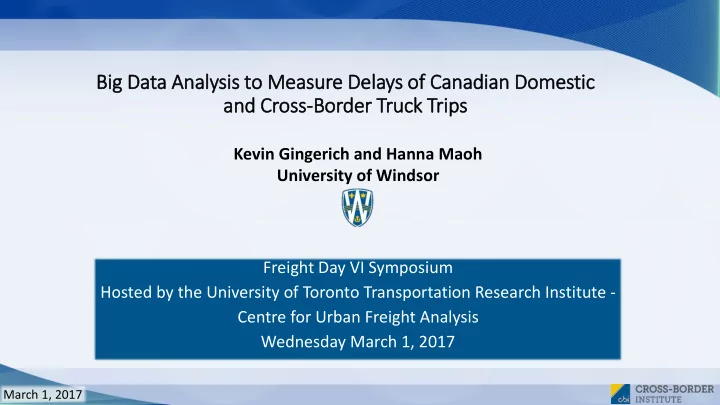

Bi Big D g Data A Analy lysis is t to Mea easure Dela elays o of Ca Canadia ian D Domestic ic and C Cross ss-Border T Truck T k Trips Kevin Gingerich and Hanna Maoh University of Windsor Freight Day VI Symposium Hosted by the University of Toronto Transportation Research Institute - Centre for Urban Freight Analysis Wednesday March 1, 2017 March 1, 2017
Age genda • Introduction • Data Overview • GPS Data • Converting raw data into observable trips • Trip delays • Measuring delay as a function of the total trip (instead of just single location events) • Identifying cross-border delays • Separating expected / unexpected delays 2
Defi finiti tions • Big Data for transportation can be categorized as follows (ITF, 2015 1 ): • Opportunistic sensing Focus of this presentation on • Collected for one purpose, used for another • Such as GPS data from trucks truck derived GPS data • Purposed sensing • Collected for the purpose it is designed for • Such as fixed detectors, etc. • Crowd sensing • Using content sharing platforms such as facebook, twitter, etc. to understand individuals and their travel patterns 3 1 International Transport Forum (ITF) 2015. - Big Data and Transport: Understanding and Assessing Options.
Data ata • In this presentation, we use a dataset of GPS pings observing truck movements across Canada and the continental U.S. Data Statistics For a one month period occurring in July, 2013 30,000 Canadian owned trucks Owned by 580 carriers Carrier Truck Latitude Longitude Day Time • Each GPS ping provides the location of ID ID a truck at a particular point in time 1042 554 48.47848 -114.14864 20130302 145845 1042 589 52.54987 -108.13242 20130309 224532 1165 1147 47.34894 -109.78547 20130328 062234 Data shown here is artificial 4
Stop E Events ts • As part of the data processing, the purpose of a stop event is estimated as either: 1. Primary stop – Vehicle is stopped to transfer goods 2. Secondary stop – Vehicle is stopped for other purposes such as fuel refills, driver break, etc. • The primary stops are used as end points to define trips • 221,800 trips derived for the one month period 5
Tr Trip Z Zones • The trips are aggregated (for both origins and destinations) by zones at the census division level (in Canada) and MSA or county level (In the U.S.) • The focus of this study is on trips travelling between zones (inter-zonal) 6
Trip ip D Dela lays • Part 1: Border delays 7
Border Lo Locati tions • Border wait times are analyzed at three border crossings : • Blue Water Bridge • Ambassador Bridge • Peace Bridge 8
Border C Crossing T Trips b by Or Origin Frequency 9
Border C Crossing S Stati tisti tics (m (minutes) Ambassador Bridge Blue Water Bridge Peace Bridge CAN bound USA bound CAN bound USA bound CAN bound USA bound Minimum 3.35 4.61 2.58 Median 13.6 14.3 11.3 13.1 12.3 22.0 Average 17.6 18.9 16.8 18.2 17.6 27.1 95 Percentile 42.3 48.3 48.7 48.0 47.6 69.2 10
Border C Crossing D Distributions • Crossing time distribution – Ambassador Bridge 11
Canada B Bound B Border Delays • We can determine the delay as a proportion of the total travel time since we know: 1. the delay at the bridge 2. the total travel time 12
U.S. Bo Bound und Bo Borde der Del elays 13
Trip ip D Dela lays • Part 2: Expected / Unexpected Delays 14
Ex Expect cted / / Unexp xpected D Delays • To further analyze delays, all trips (not just int’l trips) were broken down into proportions of: 1. Free flow travel (no delay) 2. Expected delay 3. Unexpected delay • Calculations require the trip travel time and the minimum/average travel times for any trip between the origin-destination zones and during the specified time of day 15
Trip Delay R Results • Only origin destination (OD) zonal pairs with at least 40 trips were retained • Reducing the trip count from 221,807 to 83,654 trips belonging to 756 zonal pairs • Average proportions include 75% for the free flow travel time (no delay); 19% for expected delays; 6% for unexpected delays • Average total delays for each origin/destination zone were also calculated • Range of values from 10% to 34% 16
Aver erage z e zone ne del delays 17
Connect cted z zones pairs • While 2 western province locations exhibit high delays, they are based on a very small sample of origin-destination pairs 5 4 Only one suitable zone pair Only three suitable zone pairs 18
Connect cted z zones pairs • By contrast, the Toronto zone has a large number of zonal pairs (32) 6 19
Trip delay a and distance • Delay and distance relationship suggests that short delays tend to have higher delays (as a proportion of the entire trip) • The adjusted line is a better representation of the actual pattern • The increase in the original line is due to a different cut-off time for valid trips that are larger than 900 km 20
Ackn knowledgements ts • We would like to thank Transport Canada , who loaned the GPS data used in this study • in addition to methodologic discussions provided by Louis-Paul Tardif and Andrew Carter • We are also thankful to the financial contributions provided by NSERC 21
Thank you f for w watch ching! 22
Recommend
More recommend